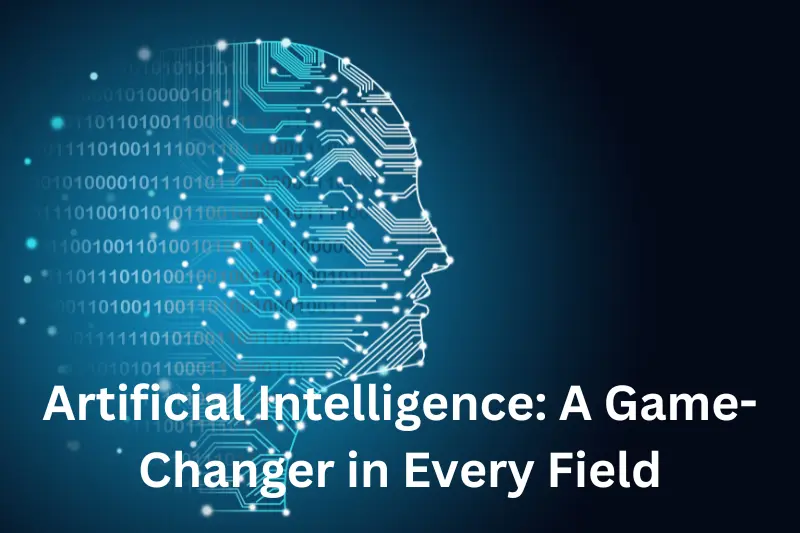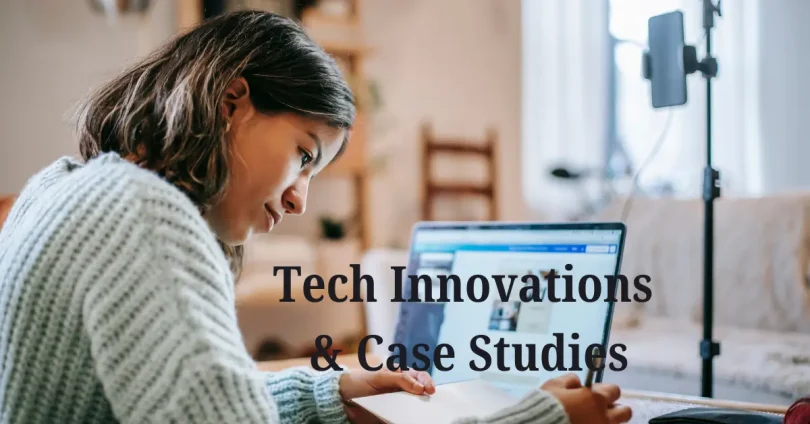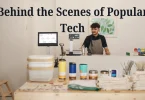In today’s fast-paced world, technology is evolving at a remarkable rate. New inventions, breakthroughs, and innovations seem to emerge almost daily, each designed to make our lives more efficient, enjoyable, and interconnected. Whether it’s advancements in artificial intelligence, sustainable energy solutions, or medical technologies that save lives, these innovations shape how industries operate and how we experience the world around us. As these technologies continue to advance, their practical applications become even more fascinating.
Many of these technological advancements are highlighted through tech innovations and case studies, where real-world examples demonstrate how these innovations solve pressing challenges, create new opportunities, and provide a blueprint for future developments. The stories behind these case studies often provide valuable lessons, showcasing the success of these innovations in action.
In this article, we’ll explore the most impactful tech innovations of recent times and share some powerful case studies that show how these technologies have changed industries and society.
Tech Innovations That Are Changing Industries
Artificial Intelligence: A Game-Changer in Every Field

Artificial Intelligence (AI) continues to lead the charge in revolutionizing industries across the globe. From healthcare to finance, AI is not just an emerging technology – it’s already a critical part of businesses striving to stay competitive. AI algorithms and machine learning (ML) models are now capable of performing complex tasks that were once thought to be impossible for machines.
- Healthcare: AI is helping doctors diagnose diseases faster and more accurately by analyzing medical images, patient records, and even genetic information.
- Finance: AI is used for fraud detection, risk assessment, and algorithmic trading, helping financial institutions manage and reduce risks more effectively.
- Customer Service: Chatbots powered by AI are being used to automate customer service functions, providing instant responses to queries and improving customer satisfaction.
5G Technology: The Next Leap in Connectivity
The rollout of 5G technology is expected to change everything from how we interact with our devices to how industries operate. Offering faster speeds, reduced latency, and more reliable connections, 5G opens up new possibilities for innovation in fields like autonomous vehicles, smart cities, and the Internet of Things (IoT).
- Smart Cities: 5G’s ultra-fast speeds enable the seamless integration of connected devices, enhancing everything from public transportation systems to energy management.
- Autonomous Vehicles: The low latency of 5G ensures that autonomous vehicles can communicate with each other and traffic infrastructure in real-time, reducing accidents and improving traffic flow.
Quantum Computing: Unlocking the Future of Computing Power
Quantum computing is one of the most talked-about innovations in recent years. While still in its early stages, quantum computing promises to revolutionize fields that rely on complex computations, such as cryptography, materials science, and drug discovery.
- Cryptography: Quantum computers can break traditional encryption methods, forcing the development of new, quantum-safe encryption techniques.
- Drug Discovery: Quantum computing has the potential to simulate complex molecular interactions, speeding up the process of discovering new medications.
Blockchain Technology: Revolutionizing Security and Transparency
Blockchain technology is perhaps best known for its role in cryptocurrency, but its applications extend far beyond that. The decentralized, transparent, and secure nature of blockchain is proving valuable in sectors like supply chain management, voting systems, and digital identity verification.
- Supply Chain: Blockchain can track the journey of products from raw materials to consumers, ensuring authenticity, reducing fraud, and enhancing transparency.
- Voting Systems: Blockchain provides a secure and transparent platform for online voting, reducing the risk of fraud and increasing voter confidence in election results.
Virtual and Augmented Reality: Changing How We Interact with the World
Virtual Reality (VR) and Augmented Reality (AR) have opened up entirely new ways for people to interact with digital content. While VR immerses users in completely virtual worlds, AR overlays digital information onto the physical world, providing a more interactive and engaging experience.
- Education: AR and VR are transforming education by providing immersive learning experiences, allowing students to interact with digital content in more meaningful ways.
- Healthcare: Surgeons are using AR to perform complex surgeries with greater precision, while VR is being used to train medical professionals in realistic environments.
Case Study 1: AI in Healthcare – IBM Watson Health
IBM Watson Health is a pioneering initiative that showcases the power of AI in revolutionizing healthcare. Leveraging the power of cognitive computing, Watson helps medical professionals make better, faster decisions by analyzing vast amounts of medical data from various sources. This AI system has transformed how healthcare providers approach diagnosis, treatment planning, and even patient care management.
- Challenge: The healthcare industry has long struggled with time constraints and the complexity of diagnosing diseases accurately. For example, diagnosing cancer requires thorough analysis of medical images, pathology reports, and patient history, which can often take a considerable amount of time, increasing the risk of delayed treatment.
- Solution: Watson analyzes thousands of data points in real-time, offering diagnostic recommendations, interpreting medical records, and identifying patterns in medical data that human doctors might miss. For example, Watson has been used to interpret mammogram images and recommend the most appropriate treatment options.
- Impact: With Watson, doctors can now make more accurate diagnoses and personalized treatment plans. This results in early detection of conditions such as cancer, allowing patients to receive treatment much sooner. Watson has already helped medical professionals in renowned healthcare institutions such as Memorial Sloan Kettering Cancer Center and the Mayo Clinic, leading to faster and more reliable diagnoses.
The long-term impact of Watson and similar AI-driven tools is expected to dramatically reduce the errors associated with manual diagnosis, optimize resource allocation in hospitals, and ultimately save lives. Watson’s ability to continually learn and adapt as it processes more data makes it a valuable asset to medical professionals.
This isn’t just content, it’s a conversation you need to be part
Guest Contributor Pieces That Boost Authority Instantly
Shocking Industry Predictions You Can’t Ignore
Engage in Ethical Tech Discussions That Spark Change
Debates & Hot Takes: Bold Opinions on Controversial Issues
Case Study 2: 5G and Smart Cities – Barcelona’s Smart City Initiative
Barcelona is leading the charge in integrating 5G technology into urban infrastructure to build a more connected, efficient, and sustainable city. The implementation of 5G has brought advanced connectivity to multiple areas of urban life, improving everything from transportation to public services.
- Challenge: Barcelona, like many urban centers, faced issues with traffic congestion, pollution, and inefficient use of resources. Public services such as waste management, energy, and water supply needed to be optimized for the city to become more sustainable and reduce its environmental footprint.
- Solution: By adopting 5G, Barcelona has introduced smart solutions like smart traffic management, sensor-based waste management, and intelligent public lighting. For instance, traffic lights in key areas are now connected to 5G networks, enabling real-time adjustments based on traffic conditions. This has helped reduce congestion and improve traffic flow, significantly cutting down emissions.
- Impact: The smart city initiative has already transformed how Barcelona functions. The smart waste management system uses sensors to detect when trash bins are full, automatically scheduling pickups to optimize waste collection routes. The city also utilizes smart grids to monitor and distribute energy more efficiently, leading to substantial cost savings and a decrease in energy consumption. Furthermore, public transportation is enhanced by real-time data analytics, reducing wait times and improving commuter experience.
Barcelona’s example illustrates how 5G is becoming the backbone of smart cities, providing the infrastructure needed to collect and analyze data from a wide range of sensors and connected devices. The success of this initiative has positioned Barcelona as one of the most innovative cities globally, attracting attention from other cities around the world seeking to replicate its success.
Case Study 3: Blockchain in Supply Chain – Walmart and IBM’s Food Safety Solution
Blockchain technology is being used by major companies to address challenges in supply chain management. One of the most notable examples is the partnership between Walmart and IBM to create a blockchain-based food safety solution that tracks products from farm to table. This initiative is helping improve transparency, reduce food contamination risks, and increase consumer trust in the products they buy.
- Challenge: Traditional supply chains often struggle with inefficiencies and a lack of transparency. When food contamination occurs, it can take days or even weeks to trace the contaminated product back to its source, potentially exposing millions of consumers to health risks.
- Solution: The Walmart-IBM blockchain solution allows food products to be traced across the entire supply chain. By using blockchain’s secure, immutable ledger, every step of a food product’s journey can be recorded and verified, ensuring transparency and traceability. This allows Walmart to quickly identify the source of contamination if an outbreak occurs, minimizing the potential for widespread health problems.
- Impact: In practice, this system has drastically reduced the time needed to trace the origin of a contaminated food product. In one case, what previously took several days to trace was completed in just a few seconds. This level of efficiency in tracking food products has the potential to save lives, reduce product recalls, and ensure better quality control. The system is also helping to reduce food waste by optimizing the distribution and storage of perishable items.
Walmart’s use of blockchain in supply chain management is a perfect example of how this technology can bring much-needed transparency and security to industries beyond cryptocurrency. With food safety at the forefront, the integration of blockchain is setting new standards for how the global food industry tracks and manages its products.
Case Study 4: Quantum Computing in Drug Discovery – Google’s Quantum AI

Quantum computing holds immense promise in transforming fields that require high computational power, and one of the most exciting applications is drug discovery. Google’s Quantum AI team has been pioneering the use of quantum computing to simulate molecular interactions, speeding up the discovery of new drugs.
- Challenge: Drug discovery is an expensive, time-consuming, and resource-intensive process. Traditional computational methods for simulating molecular structures and their interactions are limited by the processing power of classical computers. This results in longer timelines and higher costs to bring new drugs to market.
- Solution: Google’s Quantum AI team uses quantum computers to simulate molecular interactions at a level of detail that would be impossible for classical computers to achieve. These quantum computers can model complex molecules with unprecedented accuracy, enabling researchers to predict how different compounds will interact in the body. By using quantum algorithms to analyze vast datasets, scientists can identify promising drug candidates much more quickly.
- Impact: This approach has the potential to accelerate the drug discovery process, significantly reducing the time it takes to develop new medications. By using quantum computing, Google and its partners are not only speeding up the discovery of drugs for diseases such as cancer and Alzheimer’s but also making the process more cost-effective. Additionally, the ability to simulate the effects of different compounds on the molecular level could lead to more personalized treatments and targeted therapies.
While quantum computing is still in its early stages, its application in drug discovery is one of the most promising areas for the future. As quantum technology continues to evolve, the speed and accuracy of drug discovery will improve, ultimately leading to better treatments for patients worldwide.
Conclusion
The world of technology is evolving faster than ever, with tech innovations & case studies showing us how these groundbreaking developments are transforming industries and improving lives across the globe. From AI-powered healthcare solutions to blockchain-driven supply chains and quantum computing’s impact on drug discovery, these innovations are reshaping every aspect of society. By continuing to explore and understand the real-world applications of these technologies, we can unlock even greater potential for solving the challenges of today and the future. As we look forward to what comes next, it’s clear that tech innovations will continue to be a driving force in shaping the world around us.
FAQs
What are the key benefits of AI in healthcare?
AI in healthcare improves accuracy in diagnoses, speeds up treatment planning, and enhances patient care by analyzing vast amounts of medical data in real-time. This leads to earlier disease detection and personalized treatment options.
How is 5G transforming urban living in smart cities?
5G enables faster and more reliable connectivity, which powers innovations like smart traffic management, sensor-based waste collection, and intelligent energy grids, improving efficiency, reducing congestion, and promoting sustainability in cities.
How does blockchain improve supply chain transparency?
Blockchain ensures that every product’s journey is securely recorded, providing transparency and traceability in the supply chain. This helps identify issues, such as contamination, quickly, ensuring safer products and reducing waste.
What role does quantum computing play in drug discovery?
Quantum computing allows researchers to simulate molecular interactions with unprecedented accuracy, speeding up the discovery of new drugs. This reduces the time and cost involved in bringing new treatments to market.
How is VR changing education?
VR provides immersive learning experiences, allowing students to practice complex skills, like surgery, in a virtual environment. This enhances learning by offering hands-on experience and immediate feedback, especially in fields like medicine.





